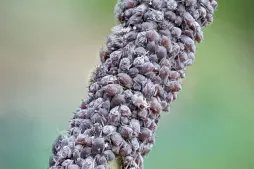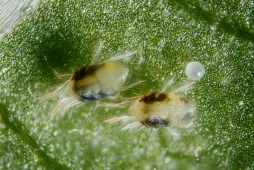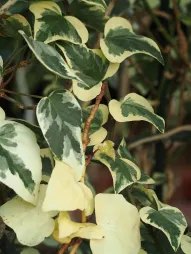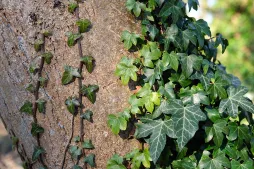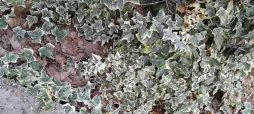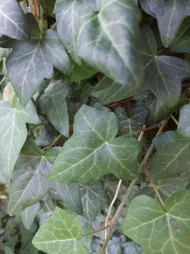Hedera algeriensis, large-leaf ivy
Ivy is grown for its decorative foliage. So if you want to make the most of it, plant a Hedera algeriensis. This species, native to Algeria and Tunisia, has leaves as big as your hand.
How to recognize Hedera algeriensis?
Hedera algeriensis is a perennial with a creeping or climbing habit. Although this sub-shrub rarely exceeds 50 centimetres in height, it can spread over 10 metres.
The woody stems are reddish and covered with gray hairs. The branches are studded with spikes that enable the plant to cling to anything it finds.
The alternate, leathery leaves are 20 cm long and 12 cm wide. As with hedera helix, their shape varies. On fertile stems, those bearing the flowers, the blades are oval, almost cordate. Sterile shoots, on the other hand, have leaves with three shallow lobes.
The color of the foliage depends on the variety. The blades of botanical Hedera algeriensis are solid green. Some cultivars, such as hedera algeriensis 'Gloire de Marengo, have variegated leaves.
Algerian ivy flowers in late summer. The yellow or green flowers are grouped in corymbs.
Once pollinated by bees, they produce black berries filled with seeds.
Although insects appreciate its melliferous flowers and birds its fleshy fruits, Hedera algeriensis is toxic. The plant contains saponins, a substance that is harmful to humans and other mammals if touched or ingested. The berries are particularly dangerous. They can cause severe digestive disorders.
Our maintenance tips
Hedera algeriensis are sometimes sold as houseplants. But they are in fact hardy and resistant outdoor plants. So hardy, in fact, that they can become invasive! Think carefully before planting your specimen. Once it's in the ground, you won't be able to move it.
Watering
Water your Hedera algeriensis when the potting soil has dried on the surface, for at least three centimetres.
Supply the plant with non-calcareous water at room temperature. Rainwater is best. If you don't have any, you can filter mains water or leave it to stand for 24 hours.
After watering, check the saucer or planter. If stagnant water appears, empty it. It could rot the roots.
Repotting
Choose a pot with holes larger than the previous one. Two centimetres more in diameter and depth will suffice. Line the bottom with clay balls or gravel to optimize drainage.
Pour in a layer of universal potting soil. Plant your Hedera algeriensis and add substrate.
Planning to climb your plant on a wall or pergola? The stems should find their way up on their own. But you can help them a little by arranging the branches on the support.
Fertilization
To promote the growth of your Hedera algeriensis, apply fertilizer in spring and summer.
To stimulate the growth of your Hedera algeriensis, use a liquid fertilizer for green plants.
Apply a dose of compost at the foot of the plant.
Prune
Your Hedera algeriensis is a fast-growing plant. You need to prune it to control its spread and prevent it from invading you.
Arm yourself with a clean, sharp tool. Depending on the diameter of the stems, you may choose scissors or pruning shears.
Remove dead branches by cutting at their base.
Shorten branches that have become too long by cutting just above a node. This encourages branching and helps maintain a compact habit.
Plantation
When the risk of frost has passed, it's time to plant.
Soak the rootball in a bucket of water at room temperature. Meanwhile, dig a hole twice the size of the rootball.
Plant your Hedera algeriensis without burying the collar. Fill in with your garden soil and water.
The plant will naturally cling to its support. But you can encourage it to do so by arranging the branches against the wall or trellis you've planned.
Cutting
Cutting is carried out during the strong growth phase, generally in spring and early summer.
Using disinfected pruning shears, remove a stem ten to fifteen centimeters long. Remove the leaves at the base and keep those at the top.
Get a pot with holes to suit the size of your seedlings. Line the bottom with clay balls or gravel to improve drainage.
Pour in a rich, light substrate, such as potting soil, and plant your cuttings. To help you, you can use a pencil to form a pilot hole.
Water to encourage rooting and eliminate air bubbles.
Diseases / Threats
Information
| Family | Araliaceae - Araliaceae |
| Type | Ivy - Hedera |
| Species | Hedera algeriensis - Hedera algeriensis |
| Lifecycle | Perennial |
| Foliage | Evergreen |
| Exposures | |
| Substrats | |
| Planting methods |
Open ground In pots In tubs Planter |
| Categories | |
| Tags |
Beginner Invasive Toxic |
| Origin |
North Africa |
| Hardiness (USDA) | 9a |
| Leaf color |
|
| Flower colors |
|
| Fruit color |
|
Discover plants from the same family












